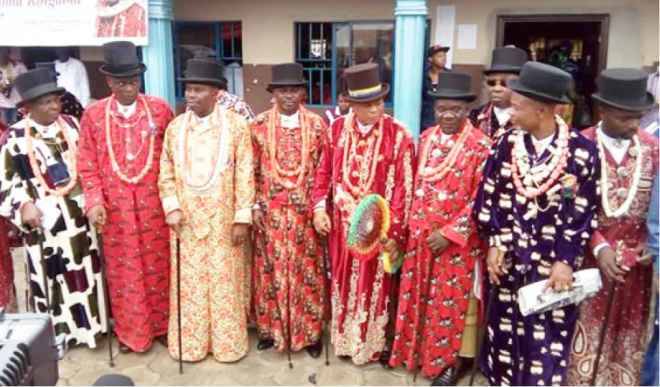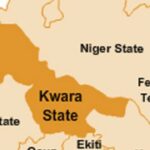
The reverence for the Eze Ekpeye Logbo stool transcends its native Rivers State and spreads across the entire Niger Delta Region. The stool serves the Ekpeye people mostly found in Ahoada East and Ahoada West.
The Ekpeye people, according to Late Good Ezekiel of Ebiriba in his book ‘Ekpeye Map’, have long lived in the land bordered by River Orashi in the West and Rivers Sombreiro in the east, starting out at the northern end from about 425AD during the reign of Oba Ewuarre of the great ancient Benin Empire.
From oral tradition, the progenitor of Ekpeye is called Akalaka. Historical narratives had it that a minority of Ekpeye moved up north and founded what is now Ogba land, whose language plainly bears the imprints of the Igbo languages. The commonest historical narrative in Ogba and Ekpeye is that they were both the sons of the same father born of different mothers. At about 1425 AD, during the reign of Oba Ewuare of Benin kingdom, Ekpeye was at its most glorious moment just as its culture was widely spread.
Ogba, which majorly has similar culture to the ancient Benin kingdom, was said to have created the theory that its progenitors was a prince of Benin. His name was given as Akalaka which does not match any personality in Benin history. The man known today as the father of Ekpeye and Ogba is now held by some historians to have left Benin kingdom due to infighting within the royal family. He is said to have fled with his family as a result of his disloyalty to Oba. They were said to have moved southwards towards the River Niger where they eventually settled with the members of all the seven original distinct families of Ekpeye such as Imaji, Uchi Agolo , Uzhi , Ishikoloko, Edywulu and Akpa .
Ekpeye people practiced full representative democracy. But the challenges of the politics of colonial government forced a change. Apart from this, they were known to be great warriors. This was demonstrated by Onje Nworisa Odu, who hailed from Ogbele community, and was said to have prevented the colonialists from entering their community. After valiantly fighting off the colonial takeover, Nworisa was later lured to Degema, the colonial administrative centre, where he died later in about 1890.
Eze Ashirim Edmund Unoshi, who later became the first Eze Ekpeye Logbo, brought peace, publicity and pomp to the Ekpeye kingdom just as the stool came with recognition by the Nigerian government, a move that added the political influence of the stool in the region.
Although many traditional stools in the region are hereditary, the Ekpeye monarchy is one of a few which relies upon a democratic process in selecting a king. It is generally believe in the area that every Ekpeye son is a prince and therefore a potential occupant of the stool when it becomes vacant.
Late Edmund Ashirim Unoshi who was born at Ihuaba, a community in Ahoada East Local Government Area of the State was the first Eze Ekpeye Logbo.
The late Ekpeye Monarchy made a presentation to the colonial government in 1946 on the need to grant recognition to an overall clan head for Ekpeye in line with Ekpeye ancestral culture as derived from Benin.
The recognition came after a relentless effort, just as the late monarch was elected the first Eze Ekpeye logbo of Ekpeyeland . The status empowered him to represent the Ekpeye people at the Eastern Region House of Chiefs and today, the stool has become a rallying point for Ekpeye.
The late monarch passed on in 1977 but his acts of kindness and genuine love for his people is still fondly remembered.
After the death of Eze Ashirim, Eze Robinson .O. Robinson, a retired Air force Flight Lieutenant was next to ascend the throne.
Born to a modest Christian family at Odiereke, Ubie in Ahoada West Local Government Area of Rivers State on March 13, 1940, at age 16 the he enlisted into the army and served in various formations including the Reconnaissance Squadron, Kaduna, Lagos Garrison Organization and Nigerian Army Ordinance Depot, Lagos. After his time in the army, the young Robinson was transferred to the Nigerian Air Force in 1966. He was Personal Assistant to the first Nigerian Chief of Air Staff, Aide-De-Camp [ADC] to the Military Governor of Plateau State. Robinson was also a Training Instructor at the Nigerian Air Force, Administrative office in Port Harcourt. He voluntarily retired from the Air Force in November 1979 with the rank of Flight Lieutenant when he was called to ascend the throne of Eze Ekpeye Logbo of Ekpeyeland, a first class traditional institution.
His Imperial Majesty, Eze Robinson, a Commander of the Order of the Niger was appointed the first Chairman of the Rivers State Council of Traditional Rulers and Chiefs in 1983. Described in the royal circles as the ‘Lion of Ekpeyeland’, Eze Robinson holds numerous awards and is known for his modesty, generosity, clarity of thought and statesmanship.
Ekpeye cultural symbols
Ekpeye people, according to an extract from an autograph, ‘Ekpeye Kingdom’, are believed to be dynamic with a culture that is a complex mix of original Ekpeye, Ijaw and Igbo cultures. The culture is most similar to that of the Igbos because of their interaction with the Igbos in the early days. For instance the Egbukele mask, which reached Ekpeye from Ijaw land via Abua, is considered the major mask in Ekpeye lore.
Some deeply rooted Ekpeye people still live according to rules and practices set about centuries back. For example, they believe that a woman is married into a family and not a man.
The monarch’s fish-shaped head gear
The horizontal fish-shaped head gear and other animal representation found on the attire of the monarch symbolize the bravery and warrior nature of a typical Ekpeye man. While the red regalia is derived from the ancient Benin Kingdom and represents heroism.
The palace has very simple protocols. Visitors to the palace are received on appointment secured through the palace staff. The visitors are seated before the arrival of the king. As soon as the king is ushered into the palace the visitors are expected to rise and greet the king saying, ‘’Eze Ekpeye Logbo! Eze Ekpeye Logbo!’’
Obgaland, where second-longest reigning monarch rules
The Oba of Ogbaland, His Eminence Sir Dr Chukuemela Nnam Obi II is the second longest reigning monarch in the country.
Sir Nnam Obi, a onetime Chairman of Rivers State Council of Traditional Ruler was born November 20th, 1942 into the Royal family of Umueze-Ogba, Umu Okoya Umuebe kindred of Ogba.
His father, Obuoha Obi, reigned as Obi Chukwuma. Sir Chukuemela Nnam Obi has been on the throne of Oba of Ogba land for more than 45 years. Ogba, or Ogbah according to other sources are indigenous Igbo speaking people located in the Rivers State of Nigeria.
The Ogba comprises of fourteen extended families divided into clans and occupy an area of about 600km in the Niger flood plains, all coming up to a population of about 303,000.
Ali-Ogba speaks the Ogba language, a dialect of Igbo language consisting of the Egi and Igburu sections. They both speak one dialect with little difference from each other, having a combine population of about 280,000 people. It is located in the central Sombreiro plains of Rivers State. Ogba is one of the major producers of crude oil that fuels Nigeria’s economic development in recent decades.
According to current oil company record no local government area produces as much crude oil and gas as the people of Ogba/Egbema/Ndoni local government area.
Ogba legend and oral history according to Wikipedia indicate that the ancestors arrived in present Ogbaland in 3015 BC. Archaeological evidence shows that many towns and villages of Ogbaland were inhabited between 3015BC to 235AD having travelled from Benin.
Sir Dr Chukumela Nnam Obi’s palace is located in the ancient kingdom of Omoku. The community has a population of about 200,000 people.
Omoku is located in the northern part of the State, near the boundary with Delta State and Imo State. It is the capital of the Ogba /Egbema/Ndoni local
Government area of the State. It is also the capital city of Ogba land.
The Oba’s regalia
The Oba of Ogba land is always decked in a red regalia with necklace made of beads. His royal cap is also made with beads which runs down to his shoulders.
Palace protocol is embedded in the rich cultural heritage of Ogba land. The Oba is always surrounded by his Chiefs and palace officials who pilot affairs in the palace when there is a visitor.
The palace chiefs are seated while a visitor is ushered in. The Oba comes in as soon as the visitor is seated. One of the chiefs moves round to greet the visitors in Ogba language and display the bravery a typical Ogba man is noted for before the official introduction. The visitor is served with grand fish and kola.




